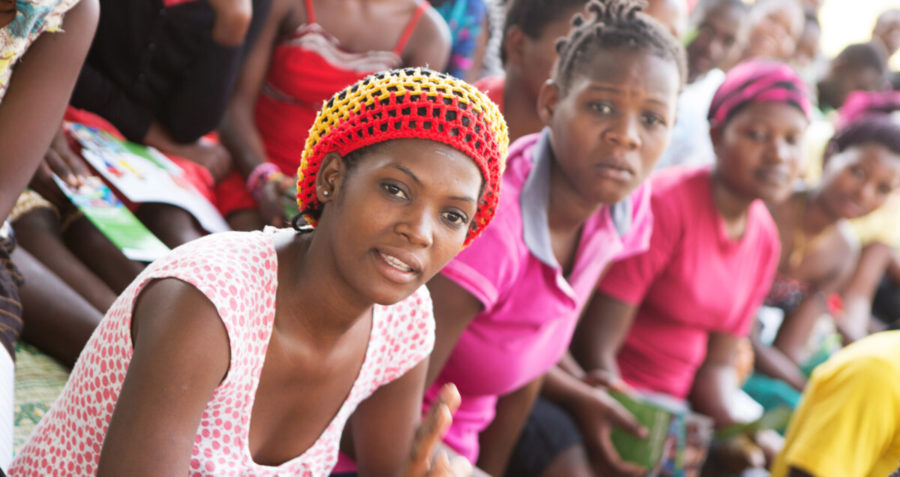The 40 billion dollar question: Where is HIV?
 © Frontline AIDS/Peter Caton/2015
© Frontline AIDS/Peter Caton/2015
A financial pledge to advance gender equality will change the lives of millions of women and girls and gender-diverse people around the world. But what will really change for those most impacted by HIV?
Last week world leaders, philanthropic foundations, civil society, and feminist leaders came together in Paris and online for the Generation Equality Forum (GEF) – a once in a decade meeting designed to revitalise action on gender equality. The Global Acceleration Plan that was launched at the forum will set the global agenda for the next five years, supported by USD $40 billion in commitments from governments, philanthropic organisations, the private sector, and civil society. Yet, for many – including HIV activists – the road ahead is still unclear.
Disappointingly, despite the fact that the relationship between gender and HIV is well documented, HIV was largely absent from the GEF discussions, and does not feature prominently in the Global Acceleration Plan. The timing of the forum, hot on the heels of the High Level Meeting on HIV, meant that many in the HIV movement were not able to engage with both events. Opportunities to make the links between gender inequality and HIV at and through GEF were missed.
Why should HIV have been more visible?
HIV is still the leading cause of death in women aged 15-49. Latest UNAIDS data shows that six out of seven adolescents aged 15-19 acquiring HIV in Sub-Saharan Africa are girls and young women, and gender-based violence increases the risk of acquiring HIV by up to 200%. The AIDS epidemic has been described as one of the most devastating gendered crises facing the [African] continent in the late 20th century. Yet we were struck by how rarely HIV was mentioned in the Forum and in funding commitments, and by the worrying silence – or even absence – of key allies of the HIV movement.
This is a real problem, given that key themes of Generation Equality are so central to the HIV response – particularly GBV, sexual and reproductive health and rights (SRHR), economic justice and feminist leadership and movements led by women and girls, and gender diverse people. Furthermore, grassroots mobilisation in the HIV response has been recognised as one of the most compelling and radical models of activist care.
Were there any wins for HIV?
The big win for HIV advocacy in the lead-up to Paris was the explicit referencing of women and girls living with and most affected by HIV, transgender, intersex and nonbinary people, sex workers and other historically marginalised people, in the vision for feminist leadership and movement building.
The Acceleration Plan is inconsistent in terms of how inclusive it is of women, girls and gender-diverse people most impacted by HIV. However, an intersectional approach which recognises HIV status and gender identity and sexuality is used in the areas focussing on gender-based violence and feminist movements and leadership. This gives us more leverage to work with donors and decision makers to fund HIV programmes which contribute to achieving the goals of GEF.
At the Paris Forum
We were encouraged to see that the meeting was inclusive of transgender, intersex and gender non-binary people with a number of sessions having strong transgender speakers and vocal allies, and LGBT+ organisations and activists represented.
Frontline AIDS participated in the launch of the Global CSE partnership led by UNESCO and UNFPA. We hope this multi-stakeholder partnership of 80 organisations, governments and UN agencies will include a strong focus on the rights and priorities of people living with and affected by HIV.
Our partners Education as a Vaccine (EVA Nigeria), Sexual Minorities Uganda (SMUG) and RedLacTrans based in Argentina spoke in sessions on gender and HIV, challenging anti-rights movements, and violence against transgender people, respectively.
UNAIDS launched its flagship high level advocacy initiative on achieving universal secondary education for girls in Sub-Saharan Africa, Education Plus. This initiative aims to address HIV as a gender issue by keeping girls in secondary school, providing comprehensive sexuality education (CSE), promoting SRHR, and addressing gender-based violence.
Feminist activists Doreen Moraa Moracha (GEF Youth Task Force) and Saidy Brown (She Decides Champion) also spoke out as young women living with HIV, to highlight intersectional issues between gender and HIV.
So, what about those 40 billion dollars?
A number of key questions remain: we have yet to see how the accountability framework to track commitments made at the Forum will be developed and by whom. How much of the $40 billion funding will make its way to grassroots community- and youth-led organisations, and how will this be tracked?
We need meaningful community engagement with the Acceleration Plan to deliver and track these commitments. This means fully resourcing women- girl- and trans-led organisations, and moving away from some of the tokenistic involvement of young women and marginalised groups that was raised as a concern by the Young Feminist Manifesto and the Open Letter from Girls.
What happens next?
Frontline AIDS has made tangible commitments to deliver on the Generation Equality Commitments around gender based violence, SRHR and feminist leadership. We will build our collective action on gender equality, and hold commitment makers to account to ensure that women, girls and gender-diverse people living with HIV benefit from commitments that have been made to ‘the most marginalised’ and ‘women and girls in all their diversity’.
We call on commitment makers, including our partners and donors, to honour their funding pledges and act on HIV in the delivery of their commitments.
Thank you to Emma Bell and Fiona Hale for their contributions to this blog.
Tags
GenderGender equalityHIV preventionSexual and reproductive health and rights (SRHR)

